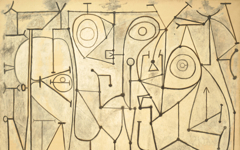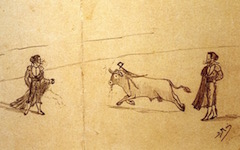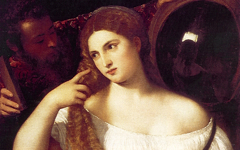Picasso’s Portrait of a Girl and a Bull
Scholars have long thought that Picasso’s depictions of bulls are symbols of the Spanish artist himself but their insights, though correct, still remain hunches. Yet, if you know what to look for, confirmation is often at hand.
Picasso loved using letters in his art and he used them in this 1901 sketch to demonstrate that the bull is a representation of himself. You can see at the top of the head that the lines form an approximate YO, the Spanish for ‘I’.
Click next thumbnail to continue
A year earlier he had painted a large YO to the left of his face in one of his earliest "self-portraits". Although now called a self-portrait, it is really a fusion of his face with a well-known image of Beethoven and the YO is there to say: "I am Beethoven." Picasso's sense of identification with great masters in any medium, as with bulls and other animals, was intense.
Click next thumbnail to continue
Take a closer look at the bull, though. The ‘O’ is formed around the bull’s eye, indicating that the bull’s eye and the artist’s eye are one. By careful placement of the letters, he has added meaning.
Click next thumbnail to continue
Picasso often used the word ‘Yo’ to express self-representation. John Richardson reports how he wrote “Yo, el rey” or “I, the king” three times underneath a now lost self-portrait.2 In addition the artist’s interest in the reincarnation of great masters is illustrated in his drawing of an El Greco-like head (left) under which he wrote: “Yo, El Greco.”
Click next thumbnail to continue

Picasso, Portrait of a girl illustrating a book of poems by Luis de Góngora (1942)
Click image to enlarge.
And no-one has noticed that in 1942 he placed the word ‘Yo” in the eye of a woman’s head intended to illustrate a book of Baroque poems by the Spanish poet, Luis de Góngora. Once again, he used the pupil for the ‘O’. The woman, like the bull, is an alter ego of Picasso.
More Works by Picasso
Picasso at his most abstract is still figurative in ways that have never been seen

Picasso’s The Kitchen (1948)
Notes:
1. Picasso in The Metropolitan Museum of Art (New York) 2010, pp.16-17
2. Picasso and Portraiture (New York: Museum of Modern Art) 1996, pp. 118-9
Original Publication Date on EPPH: 06 Sep 2010. | Updated: 0. © Simon Abrahams. Articles on this site are the copyright of Simon Abrahams. To use copyrighted material in print or other media for purposes beyond 'fair use', you must obtain permission from the copyright owner. Websites may link to this page without permission (please do) but may not reproduce the material on their own site without crediting Simon Abrahams and EPPH.






